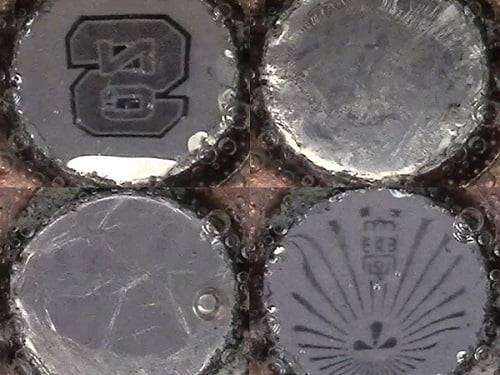Liquid Metal Enables Switchable Mirrors
2021.06.28 / By admin
Mirrors and other reflective optical components are typically created through the use of optical coatings or polishing processes. The researchers’ approach, developed by a team led by Yuji Oki of Kysuhu University in collaboration with a team from North Carolina State University led by Michael Dickey, used an electrically driven reversible chemical reaction to create a reflective surface on the liquid metal.
Switching between the reflective and scattering states can be done with just 1.4 V, about the same voltage used to light a typical LED, and at ambient temperatures.

Researchers have developed a way to dynamically switch the surface of liquid metal between reflective (top left and bottom right) and scattering states (top right and bottom left). When electricity is applied, a reversible chemical reaction oxidizes the liquid metal, creating scratches that make the metal scattering. Courtesy of Keisuke Nakakubo, Kyushu University.
“In the immediate future, this technology could be used to create tools for entertainment and artistic expression that have never been available before,” Oki said. “With more development it might be possible to expand this technology into something that works much like 3D printing for producing electronically controlled optics made of liquid metals. This could allow the optics used in light-based health testing devices to be easily and inexpensively fabricated in areas of the world that lack medical laboratory facilities.”
In the work, the researchers created a reservoir using an embedded flow channel. They then used a “push-pull method” to form optical surfaces by either pumping gallium-based liquid metal into the reservoir or sucking it out. This process was used to create convex, flat, or concave surfaces, each with different optical characteristics.
From the application of electricity, the team induced a reversible chemical reaction, which oxidizes the liquid metal in a process that changes the liquid’s volume in such a way that many small scratches on the surface are created, which causes light to scatter.
When electricity is applied in the opposite direction, the liquid metal returns to its original state. The liquid metal’s surface tension removes the scratches, returning it to a clean reflective mirror state.
“Our intention was to use oxidation to change the surface tension and reinforce the surface of the liquid metal,” Oki said. “However, we found that under certain conditions the surface would spontaneously change into a scattering surface. Instead of considering this a failure, we optimized the conditions and verified the phenomenon.”
Tests showed that changing the voltage on the surface from −800 mV to +800 mV would decrease the light intensity as the surface changed from reflective to scattering. The electrochemical measurements revealed that a voltage change of 1.4 V was sufficient to create redox reactions with good reproducibility.
“We also found that under certain conditions the surface can be slightly oxidized and still maintain a smooth reflective surface,” Oki said. “By controlling this, it might be possible to create even more diverse optical surfaces using this approach that could lead to applications in advanced devices such as biochemical chips or be used to make 3D-printed optical elements.”

